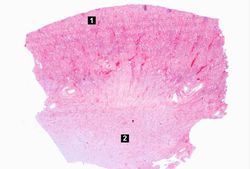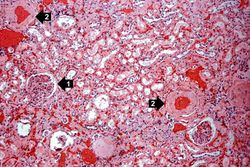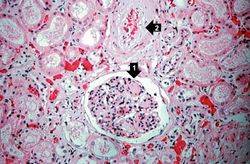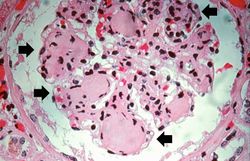Difference between revisions of "IPLab:Lab 5:Nodular Intercapillary Glomerulosclerosis"
Seung Park (talk | contribs) (→Images) |
|||
| Line 31: | Line 31: | ||
=== Images === | === Images === | ||
| − | * [ | + | * [{{SERVER}}/library/index.php?/tags/137-diabetic_glomerulosclerosis PEIR Digital Library: Diabetic Glomerulosclerosis Images] |
* [http://library.med.utah.edu/WebPath/RENAHTML/RENALIDX.html#3 WebPath: Interstitial Diseases of the Kidney] | * [http://library.med.utah.edu/WebPath/RENAHTML/RENALIDX.html#3 WebPath: Interstitial Diseases of the Kidney] | ||
Revision as of 01:33, 30 August 2013
Contents
Clinical Summary[edit]
This 57-year-old white male with a 25-year history of Type I diabetes mellitus (insulin-dependent ) developed an acute myocardial infarction followed by cerebral infarction, pulmonary dysfunction, and renal failure. There was a history of hypertension and proteinuria. Laboratory findings included a BUN and creatinine of 69 mg/dL and 3.3 mg/dL which subsequently rose to 113 and 4.8, respectively. He subsequently died of multisystem failure.
Autopsy Findings[edit]
The autopsy showed the expected left ventricular hypertrophy, a large acute myocardial infarction, and a large right cerebral infarction. The pancreas showed amyloidosis of the islets. There was extensive atherosclerosis and arteriolosclerosis. The kidneys were slightly enlarged, weighing 220 and 240 grams respectively, and had rough surfaces, a few cortical scars, and blurring of the corticomedullary junctions.
Images[edit]
Study Questions[edit]
Additional Resources[edit]
Reference[edit]
- eMedicine Medical Library: Type 1 Diabetes Mellitus
- eMedicine Medical Library: Type 2 Diabetes Mellitus
- Merck Manual: Diabetes Mellitus (DM)
Journal Articles[edit]
- Herzenberg AM, Holden JK, Singh S, Magil AB. Idiopathic nodular glomerulosclerosis. Am J Kidney Dis 1999 Sep;34(3):560-4.
Images[edit]
- PEIR Digital Library: Diabetic Glomerulosclerosis Images
- WebPath: Interstitial Diseases of the Kidney
Related IPLab Cases[edit]
| |||||
Myocardial infarction is necrosis of myocardial tissue which occurs as a result of a deprivation of blood supply, and thus oxygen, to the heart tissue. Blockage of blood supply to the myocardium is caused by occlusion of a coronary artery.
Renal failure is the severe reduction of renal function and often leads to reduced urinary output.
Protein in the urine is indicative of glomerular dysfunction.
These tests are measures of kidney function. High levels mean low function.
A normal BUN for this patient would be 10 to 20 mg/dL.
The normal creatinine level is 0.7 to 1.3 mg/dL.
A normal kidney weighs 157 grams (range: 115 to 220 grams).
Nodular hyperplasia of the prostate--characterized by large discrete prostatic nodules--is a common disorder in men over 50 years of age. The nodules cause the prostate to be enlarged and to have an increased weight. The human prostate is surrounded by a restrictive capsule. These nodules cause increased pressure within the capsule which leads to constriction of the urethra as it passes through the prostate. Urethral constriction leads to retention of urine.






